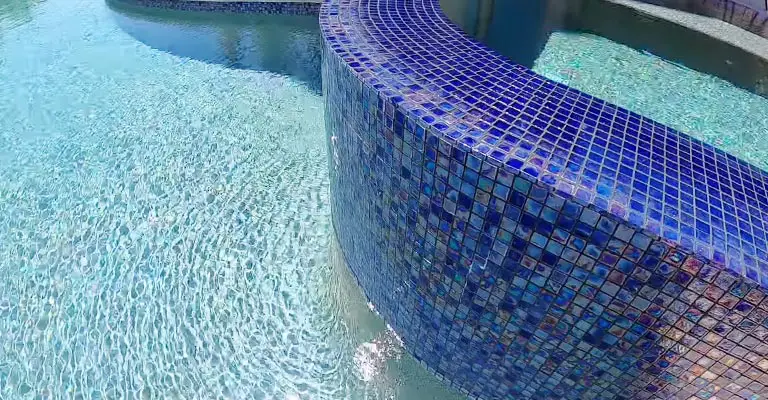Rather than tiling the entire interior, many people finish swimming pools with waterline tiles. Besides looking good, it’s also cost-effective.
Clean waterline tiles make swimming a whole lot more enjoyable, but dirty waterline tiles ruin the whole look.
Eventually, the waterline gets grimy and discolored where the pool water meets the tile edge.
Here are a few strategies to keep your waterline pool tiles clean all year if you’re not hiring a pool maintenance team.
Cleaning waterline pool tiles shouldn’t be too hard depending on the stain and scaling, and how long it’s been sitting.
However, it can take a while. Work in small increments if you have extensive discoloration on the surface.
In the long run, this will help reduce the amount of grime and algae in your pool.
Removing Stains And Scaling From Waterline Tiles
You can clean pool tiles around the waterline by following these steps:
Make Sure All Organic Materials Are Cleaned Up
Any organic material or debris on the surface, like soil, leaves, or grass clippings, needs to be cleaned away. Using a vacuum or your hands will speed things up.
Make Sure Your Waterline Tiles Are Brushed
Using a stiff brush, work quickly in circling motions to remove the calcium carbonate. Use a toothbrush that’s gentle on glass tiles if the buildup is minimal and you’re working in smaller areas.
Get A Cleaner
You can clean a small area with homemade cleaners like vinegar with water, baking soda and vinegar, toothpaste, or dish soap if your dirt and grime is minimal.
You’ll need a pumice stone to clean tough stains or calcium silicate scaling. While you’re scrubbing, work gently and keep the tiles and pumice wet to prevent scratches.
If the stains are really stubborn, you might have to use a sulfamic acid-based cleaner or a commercial tile cleaner. Using these cleaning chemicals should be done with caution because they’re harsh and acidic.
If you’re cleaning waterline pool tiles, test on a small patch or talk to your supplier. Be sure to wear protective gloves and wait a couple of days before using the pool.
Soda Blasting Might Work For You
Trying soda blasting may work if you’re having trouble removing stains from waterline tiles.
Baking soda is blasted out of a high-pressure nozzle and is preferable to salt or glass bead blasting for waterline glass tiles.
Consider consulting a team before doing this DIY job, since this is typically a professional job.
How To Clean Pool Waterline Tiles Step By Step
In most cases, pool staining happens when a chemical imbalance in the water reacts with the surfaces of the pool. You probably get your pool cleaned regularly by your pool maintenance company.
For a clean pool, frequent cleaning is required, especially if you’re cleaning it yourself. Otherwise, stains may become so hard to remove that you have to replace the tiles.
1. Get Rid Of All Organic Stuff
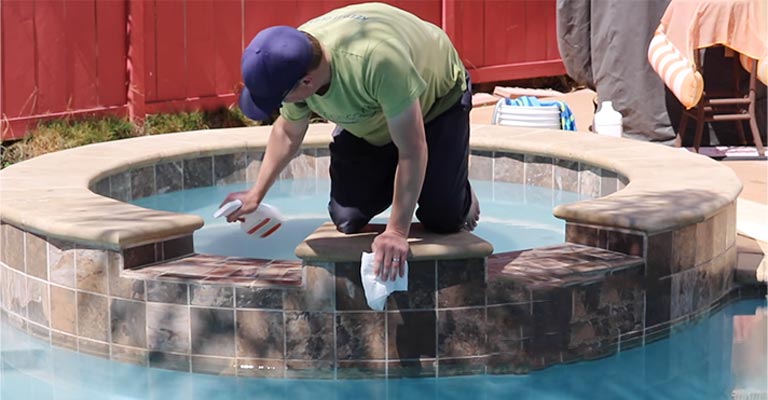
Prior to cleaning your pool, use a pool vacuum or net skimmer to remove leaves, grass clippings, and other organic matter.
2. Lower The Waterline
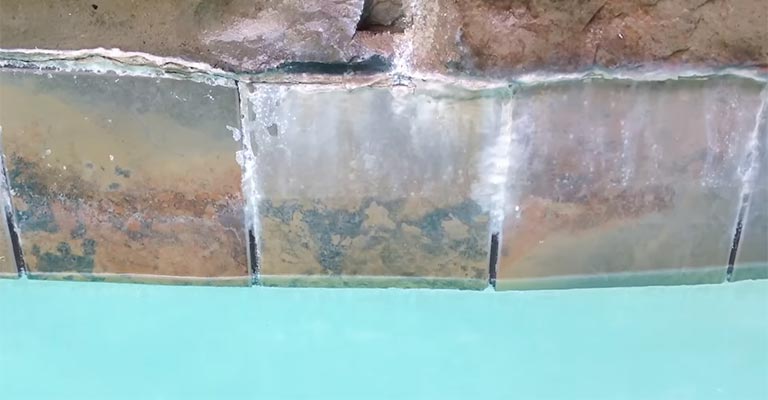
Your pool’s waterline should be slightly lower than usual so you can clean the stained tiles more easily. This can be done with a pool pump, but in a pinch, you can skip it.
3. Use a Scrub Brush
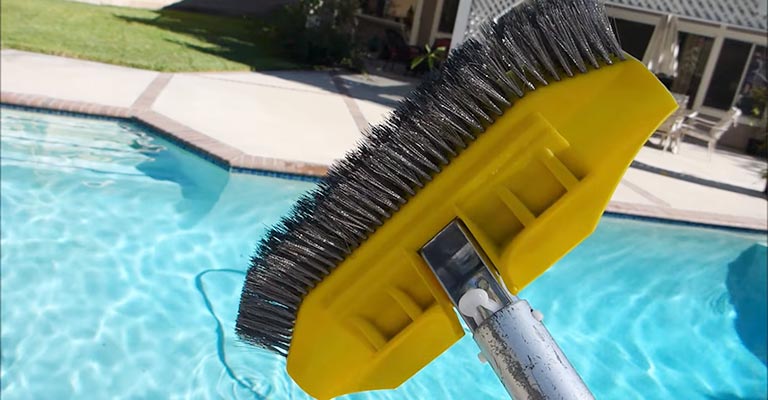
You can scrub away mineral deposits with a stiff-bristled scrub brush (no wire bristles). Using a circular motion, work over a three- to four-foot area.
To avoid scratching glass tiles, use a soft-bristled brush.
Electric scrub brushes with interchangeable heads are handy for cleaning. An old toothbrush works well for tight, small areas.
4. Remove Dirt and Grime
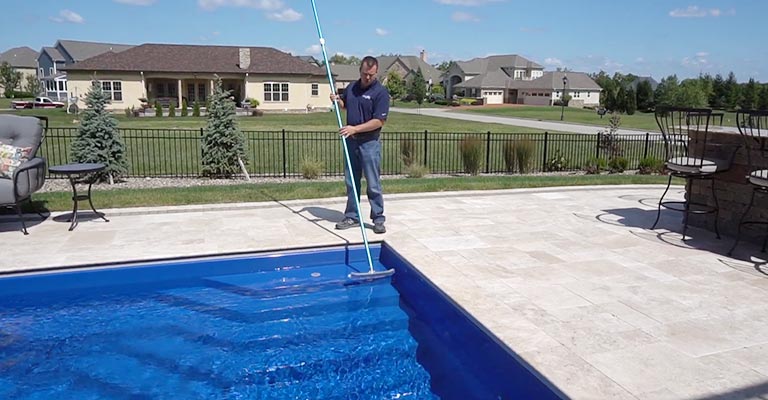
After you’ve loosened the mineral deposits, you’ll need to clean the area of body soil, dust, and grime.
If you have mixed these solutions in a bucket, you can scrub the area with one of them:
- Create a paste out of baking soda and a few drops of water
- One gallon of water and one quarter cup of dishwashing liquid
Dip the scrub brush in the solution and scrub the tiles. If you’re having trouble getting rid of stains, use a melamine sponge (like a Mr. Clean Magic Eraser).
Continue scrubbing and cleaning the perimeter of the pool as you splash pool water or freshwater on the freshly cleaned area.
5. Use a Pumice Stone
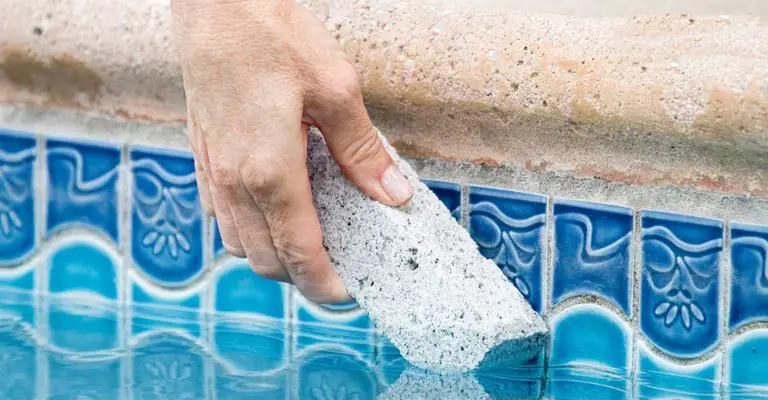
Using a pumice stone will remove mineral deposits if you use it with a scrub brush and cleaning solution.
They’re available online and at home improvement and pool supply stores. The stone breaks up deposits because it’s made of volcanic rock.
When you use a pumice stone, you’ve got to keep the stone and tile wet all the time or they’ll scratch too much. You’ll need to scrub gently in gentle circles along the waterline while using a light touch.
6. Try a Commercial Cleaner
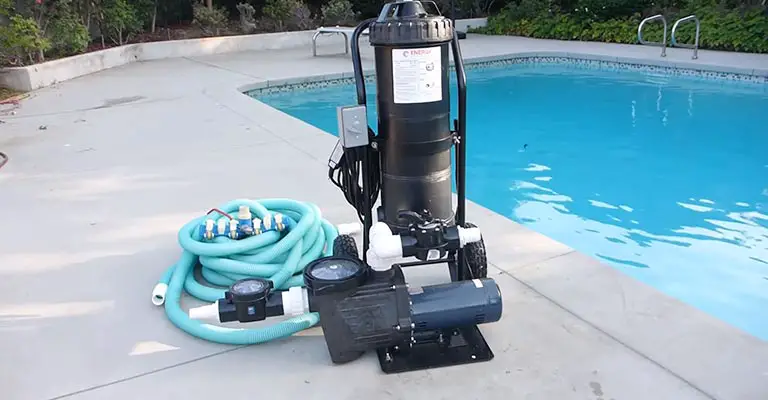
Using a tile cleaner with sulfamic acid (like Lime-Away) might help if the pumice stone didn’t remove the build-up.
Cleaning with these products is harsh and you need to be careful. The chemicals shouldn’t be added after the regular chemicals.
Before you swim in the pool or treat the water with chemicals, give the water a few days to settle.
Why Are Your Waterline Tiles Building Up?
There’s always scale or stains building up on waterline tiles.
Chemical imbalances can cause stains, or organic material like leaves and soil can cling to the surface for a long time.
It’s possible for calcium deposits to stick to the sides of a pool when water evaporates naturally.
There’s a white-grey scum on your pipes caused by calcium scaling, and it can be a hassle to get rid of. Your waterline pool tiles can get two kinds of scaling:
1. Calcium Carbonate
There will be a flaky white crust on the surface if you have calcium carbonate scaling on your pool tiles.
If you apply muriatic acid to it, it will bubble up. Pumice stones and stain erasers work well for removing calcium carbonate.
2. Calcium Silicate
There’s something called calcium silicate scaling, which looks white-grey and is harder to remove.
When applied to muriatic acid, silicate won’t react with it. Using a pumice stone and elbow grease is the best way to remove this kind of scaling.
How Often to Clean Pool Waterline Tiles
There are a number of things that accumulate on pool tiles, including body soil, sunscreen, and mineral deposits (scale).
You’ll probably have hard-water stains on your pool surface too if you have hard-water deposits in your house sinks or tubs.
In a pool, scaling happens when mineral deposits cling to the sides. There’s a white or gray scum that’s hard to get rid of.
When you see any discoloration, clean the waterline tiles as soon as possible.
When you clean small amounts of build-up at the waterline, it’s easier than when you wait until the tiles are heavily soiled. Cleaning the tiles at the beginning and end of the season should be the bare minimum.
Tip
Plan on removing the mineral deposits, algae, and dirt at the waterline over several days or weeks if the buildup is heavy.
You’ll prevent your pool’s filtering system from getting overwhelmed and keep the water’s pH in check.
When To Call A Professional Pool Cleaner
The best way to clean tile is with baking soda blasts from a high-pressure cleaner if you don’t want to work with heavy-duty cleaners.
It costs about $150 a month to have your pool cleaned regularly. It’s best to call a pool tiling professional or company to replace or repair tiles if they chip or crack.
A tiling expert will charge you about $50 to $100 an hour, not including the cost of replacing tiles. Typically, it costs $15,000 to retile an entire pool.
Preventative Measures For Clean Waterline Tiles
The best way to avoid grime and scaling on your waterline tiles is to keep your pool free from debris by regularly vacuuming and cleaning the surface.
You should also brush down your waterline tiles at the start of every swimming season by lowering the water level. You can damage your waterline tiles with staining and algae growth.
The best way to prevent long-term damage is to keep your pool chemicals at the right levels. It doesn’t matter if your pool is saltwater or chlorine.
Final Words
To keep your pool tiles clean, clean them regularly, on a schedule, to keep algae, organic debris, chemicals, and scale from building up.
Try baking soda, toothpaste, vinegar, dish soap, or Borax when you see a little scum at the water line. It won’t affect the pH of your pool water because these cleaners are gentle.

